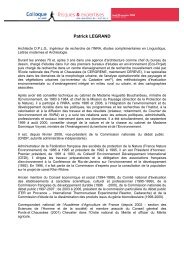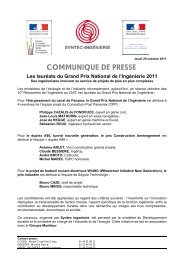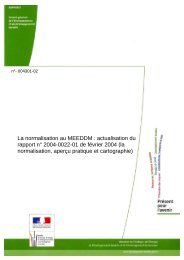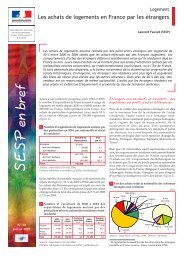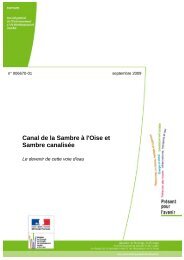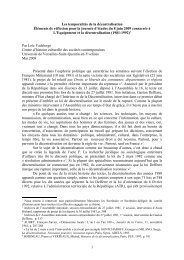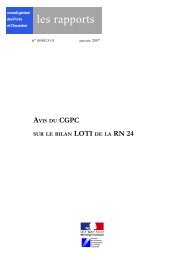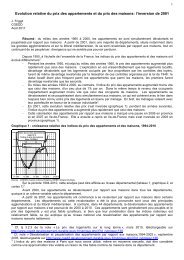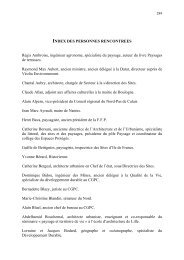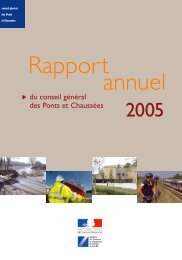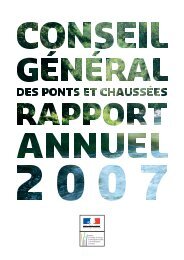Les cahiers du conseil n°3 - Automobiles et Equipement ... - cgedd
Les cahiers du conseil n°3 - Automobiles et Equipement ... - cgedd
Les cahiers du conseil n°3 - Automobiles et Equipement ... - cgedd
Create successful ePaper yourself
Turn your PDF publications into a flip-book with our unique Google optimized e-Paper software.
A U T O M O B I L E S E T E Q U I P E M E N T : E L A R G I R L E D I A L O G U E3base de connaissances statistiques <strong>et</strong> économiques pour améliorer la compréhension desévolutions croisées <strong>du</strong> véhicule automobile <strong>et</strong> de son usage.• Dans le domaine de la recherche <strong>et</strong> <strong>du</strong> développement : privilégier, de préférence audéveloppement de composants, l’approche systémique qui prévaut désormais dans laconception des véhicules ; ceci implique une réflexion sur les modèles économiques quisous-tendent l’évolution des technologies <strong>et</strong> des services <strong>du</strong> modèle automobile.• Favoriser l’innovation dans le domaine énergétique en exploitant au mieux lespotentialités de la chimie (carburants, traitement des pollutions locales <strong>et</strong> globales ycompris le CO 2 , catalyse, <strong>et</strong>c.).• Evaluer les conséquences des orientations précédentes en définissant des indicateurs<strong>et</strong> tirer de leur analyse les éléments nécessaires pour réorienter les politiques publiques.• Mieux communiquer avec les usagers <strong>et</strong> le public, en rendant plus visible lesystème de contraintes réglementaires, fiscales <strong>et</strong> techniques qui pèse sur lesvéhicules automobiles <strong>et</strong> leur usage.Quelles évolutions pour notre ministère ?C’est d’abord le souci de susciter, au sein <strong>du</strong> ministère, une meilleure prise de consciencede l’évolution de l’automobile <strong>et</strong> de son impact socio-économique <strong>et</strong> environnemental.C’est ensuite la nécessité de mieux coordonner les actions qui sont aujourd’hui tropdispersées dans les différentes directions d’administration centrale. C’est enfin le besoinde développer une véritable culture de partenariat, aussi bien avec les in<strong>du</strong>striels qu’avecles ministères en charge des technologies de pointe comme les télécommunications.Dans ces conditions, une réflexion s’impose sur la structure <strong>et</strong> les moyens à m<strong>et</strong>tre enœuvre pour que le METL continue à garantir aux usagers des véhicules automobilesle cadre réglementaire <strong>et</strong> les services qu’ils sont en droit d’attendre de notre ministère,comme c’est le cas pour le logement <strong>et</strong> le droit des sols, tout en respectant les droitsdes autres usagers de la voie publique <strong>et</strong> des riverains.En conclusion, nous proposons que c<strong>et</strong>te réflexion fasse l’obj<strong>et</strong> d’un séminaire entreles principales directions d’administration centrale <strong>du</strong> ministère, sur la base <strong>du</strong> diagnostic<strong>et</strong> des propositions <strong>du</strong> présent cahier. C<strong>et</strong>te réflexion pourrait être prolongée ensuiteavec les partenaires extérieurs, parmi lesquels figurent les in<strong>du</strong>striels de l’automobile<strong>et</strong> des télécommunications.data to improve our understanding of the interrelationship b<strong>et</strong>ween changes in the carand changes in its use.• With regard to research and development, giving priority to the system approach whichnow dominates vehicle design in preference to the development of components. Thiswill require an examination of the socioeconomic models which underlie the developmentof motor vehicle technologies and services.• Encouraging innovation in the area of energy by making the best use of the potentialitiesof chemistry (fuels, treatment of local and global pollution including carbon dioxide,catalysts, <strong>et</strong>c.).• Evaluating the consequences of the above actions by defining indicators and analyzingthem so as to gain the information on which to base a reshaping of public policy.• Improving communication with users and the public, in particular by making moreapparent the regulatory, fiscal and technical constraints which apply to motor vehicles.What changes for this ministry?Firstly, the desire to foster greater awareness in its departments of developmentsaffecting vehicles and their socioeconomic and environmental impact.Next, the need to improve the co-ordination of actions which are currently spreadb<strong>et</strong>ween the different central departments of the ministry.Lastly, there is the need to develop a genuine culture of partnership with both in<strong>du</strong>stryand the ministries responsible for advanced technologies such as telecommunications.In these circumstances, the ministry of Transport must consider the organization andresources which it needs to continue to provide car users with the regulatory frameworkand services which they have a right to expect, in the same way as with housing andland law, while respecting the rights of other users of the highways and residents.To conclude, we suggest that this topic should be the subject of a seminar involvingthe central departments of the ministry, which will take as its starting point thediagnosis and proposals put forward in this publication. This discussion could becontinued by bringing in other ministries and external partners, including the motorvehicle and telecommunications in<strong>du</strong>stries.JEAN-FRANÇOIS COSTE, IGPCMEMBRE DE LA III e SECTION “AFFAIRES SCIENTIFIQUES ET TECHNIQUES”DU CONSEIL GENERAL DES PONTS ET CHAUSSEES



